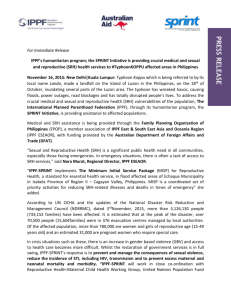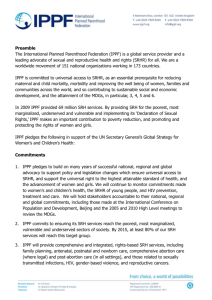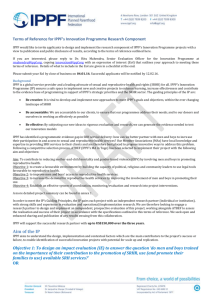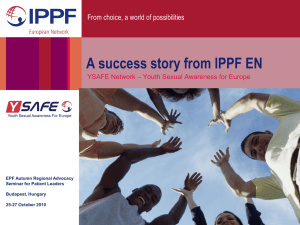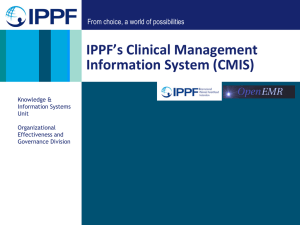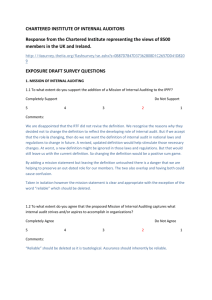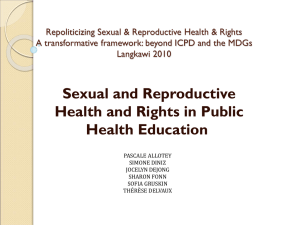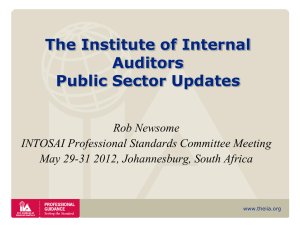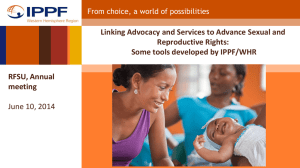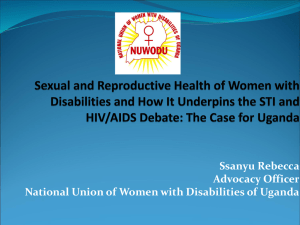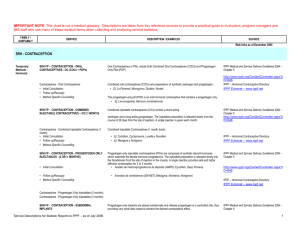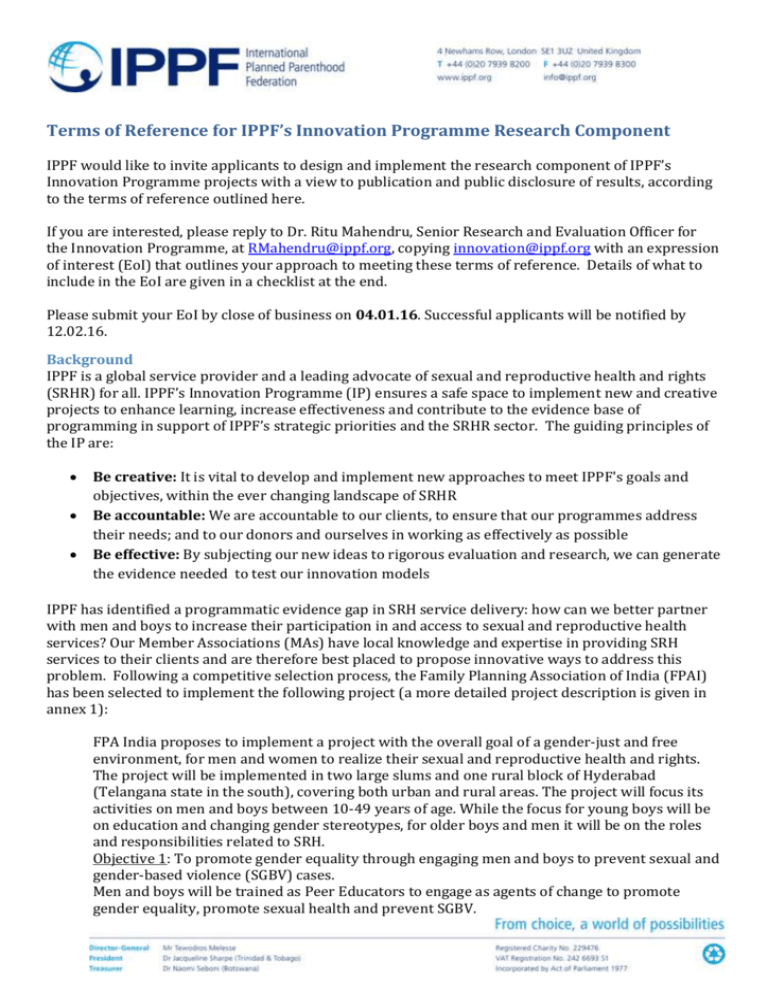
Terms of Reference for IPPF’s Innovation Programme Research Component
IPPF would like to invite applicants to design and implement the research component of IPPF’s
Innovation Programme projects with a view to publication and public disclosure of results, according
to the terms of reference outlined here.
If you are interested, please reply to Dr. Ritu Mahendru, Senior Research and Evaluation Officer for
the Innovation Programme, at RMahendru@ippf.org, copying innovation@ippf.org with an expression
of interest (EoI) that outlines your approach to meeting these terms of reference. Details of what to
include in the EoI are given in a checklist at the end.
Please submit your EoI by close of business on 04.01.16. Successful applicants will be notified by
12.02.16.
Background
IPPF is a global service provider and a leading advocate of sexual and reproductive health and rights
(SRHR) for all. IPPF’s Innovation Programme (IP) ensures a safe space to implement new and creative
projects to enhance learning, increase effectiveness and contribute to the evidence base of
programming in support of IPPF’s strategic priorities and the SRHR sector. The guiding principles of
the IP are:
Be creative: It is vital to develop and implement new approaches to meet IPPF's goals and
objectives, within the ever changing landscape of SRHR
Be accountable: We are accountable to our clients, to ensure that our programmes address
their needs; and to our donors and ourselves in working as effectively as possible
Be effective: By subjecting our new ideas to rigorous evaluation and research, we can generate
the evidence needed to test our innovation models
IPPF has identified a programmatic evidence gap in SRH service delivery: how can we better partner
with men and boys to increase their participation in and access to sexual and reproductive health
services? Our Member Associations (MAs) have local knowledge and expertise in providing SRH
services to their clients and are therefore best placed to propose innovative ways to address this
problem. Following a competitive selection process, the Family Planning Association of India (FPAI)
has been selected to implement the following project (a more detailed project description is given in
annex 1):
FPA India proposes to implement a project with the overall goal of a gender-just and free
environment, for men and women to realize their sexual and reproductive health and rights.
The project will be implemented in two large slums and one rural block of Hyderabad
(Telangana state in the south), covering both urban and rural areas. The project will focus its
activities on men and boys between 10-49 years of age. While the focus for young boys will be
on education and changing gender stereotypes, for older boys and men it will be on the roles
and responsibilities related to SRH.
Objective 1: To promote gender equality through engaging men and boys to prevent sexual and
gender-based violence (SGBV) cases.
Men and boys will be trained as Peer Educators to engage as agents of change to promote
gender equality, promote sexual health and prevent SGBV.
Objective 2: To increase the understanding of men’s roles and responsibilities in providing care
and support to women for maternal and child health care as well as abortion.
The role of men as partners will be enhanced through Private Medical Practitioners (PMPs),
family physicians trusted by families and men. PMPs would provide counselling to men
referred by Peer Educators.
Objective 3: To address SRH concerns of men and to increase services for male sexual and
reproductive health.
Improving men and boy’s own sexual and reproductive health with high quality male friendly
SRH services will be provided at two clinics in Hyderabad.
In order to meet the IP’s Guiding Principles, the IP pairs each project with an independent research
partner (individual or institution), with strong skills and experience in evaluation and
operational/implementation research. We are therefore looking to engage a research partner to
design and implement an independent, prospective evaluation of this project, working alongside FPAI
to assess the realisation and success of their project in accordance with the specifications outlined in
this terms of reference. We seek open and enhanced sharing and publication of any results ensuing
from this collaboration.
IPPF will support the successful research partner with up to US$150,000 over the three years.
Aim
IPPF aims to understand the design, implementation and contextual factors which are the main
contributors to the project’s success or failure, to enable identification of successful innovation
projects with potential for scale up and replication.
Objective 1: To design an impact evaluation (IE) to answer the following question:
Primary:
1. Does a “peer educator model” that promotes gender equality and sexual health lead to an
increase in SRH service uptake by men and boys in FPAI service delivery points (SDPs) in the
target area?
Secondary:
1. Does men’s engagement through the “private medical provider’s (PMPs)” increase their
participation in their partner’s SRH needs?’
2. Does providing men with quality SRH services through FPAI SDPs and PMPs lead to greater
SRH service uptake by their spouses?’
Please note that the question / questions stated here will be negotiated between FPAI and the
successful research applicant as part of this methodology design.
Wilkinson, R. G. & Marmot, M. 2003, Social determinants of health: the solid facts. World Health Organization, Denmark
Page
1
2
This objective aims to empirically and independently assess the success or failure of this project in
achieving its stated outcome through a theory-based experimental or quasi-experimental, mixed
methods impact evaluation. This should include an integrated process evaluation to explore the
underlying determinants1 of the project’s results, including how they are affected by project design,
implementation and contextual factors (for example, sociocultural, gender, political, legal, physical
and economic factors). This will require co-development, with FPAI, of the projects theory of change,
identifying all major assumptions along the causal chain. IPPF proposes that researchers are actively
involved in prospectively designing the project implementation along with FPAI to enable a robust,
prospective impact evaluation methodology. While a full economic analysis is not required, the IE
should consider the project’s cost effectiveness. Results of the IE will inform future project
improvements, scale-up or replication of activities in other contexts.
Objective 2: To contribute to the global body of knowledge on partnering with men and boys in
SRHR by disseminating robust evidence and lessons from this work
This objective aims to contribute to the wider evidence base on partnering with men and boys
through dissemination of the findings from the objectives above to a wide variety of appropriate
audiences, including but not limited to policy-makers, implementers and academics. Use of creative
dissemination activities and channels are encouraged, as well as publications in peer-reviewed
journals and open-access platforms.
Methodology
Current evidence on the impact of partnering with men and boys in the field of SRHR have begun to
report promising approaches, but methodological limitations persist, as exampled in a recent review
commissioned by IPPF2:
few quantitatively rigorous studies exist
many are limited to a short timeframe where impact on behaviour change may not be seen
The successful applicant will be expected to work closely with FPAI to both design and implement the
project. This work will therefore start with a project inception meeting, attended by the successful
applicant, FPAI and IPPF’s Project Support Team (PST), to agree roles and responsibilities (to be
documented in a collaboration agreement), develop an initial theory of change and create a joint
implementation plan for the duration of the project.
IPPF supports the establishment of a consortium to undertake this research piece, where consortium
partners are sub-grantees managed by the successful research applicant. In particular, international
applicants are encouraged to work with national researchers in India.
Timeline and travel
The successful applicant’s time will be spread across a maximum of 38 months. Depending on their
location, travel will likely be necessary to visit field locations and this should be included in the funds
available.
Selection process
IPPF will review all applications for adherence to the criteria set out in these terms of reference. A
combined internal and external review panel will then select a shortlist of applications based on the
cost-effectiveness of their proposed approach, as well as its technical / methodological merits in
meeting each of the objectives above and the application criteria set out below. Preference will be
given to applicants who clearly address each criterion individually.
Page
‘Engaging men and boys in sexual and reproductive health: a review of promising approaches and gaps’, commissioned
by the IPPF, 2015.
2
3
Innovative evaluation techniques are also welcome. Preference will be given to those who
demonstrate a pragmatic approach, prioritising designs that will be useful to FPAI programme
managers and decision-makers. Successful applications will therefore likely propose mixed methods
approaches, which can provide ongoing feedback to FPAI for incremental project improvement /
course correction. Given the gender-responsive nature of this project, the design will have to be
explicitly and thoroughly grounded in a gender-responsive design framework.
Consideration will also be given to the applicant’s demonstrated experience in SRHR and gender
awareness. The final selection from this shortlist will be made jointly by IPPF and FPAI and will
include consideration of logistical working arrangements.
Roles and Responsibilities
Research Partner:
Implement the proposed IP Research Component in collaboration with FPAI’s IP Project:
Work with FPAI to design the research approach to meet the objectives specified above, which
FPAI expects will include a mixed-method impact evaluation and a process evaluation that will
focus on implementation questions in annex 2.
Arrange ethics approval for the proposed IP Research Component3.
Register the proposed research on suitable evaluation registry, e.g. 3ie’s RIDIE, if appropriately
qualified for inclusion
Maintain close communication with FPAI to share findings from routine monitoring, evaluation
or research activities
Co-own data collected with other parties (IPPF and FPAI) and ensure that research findings are
publically available.
Submit to IPPF semi-annual written reports including a description of results/findings,
observations and recommendations of the research, along with a fiscal report
Author the final write-up of this research preparing various formats suitable for journal
publication and other dissemination activities & audiences, such as a plain-language, accessible
main report of not more than 60 pages (not including annexes), a four-page brief suitable for
decision-makers and an infographic.
Prepare a clear dissemination plan, including conferences, media and publication (during and
after the study)
FPAI:
Implement the IP Project in collaboration with the successful research applicant:
Maintain close communication with the successful research applicant to share findings from
routine monitoring, evaluation or research activities
Support the successful research applicant to collect and interpret data, including the sharing of
data routinely collected by FPAI where needed.
NB: Although FPAI may be able to support the successful research applicant to collect data, this
cannot be confirmed until a more detailed discussion between FPAI and the successful
applicant. Therefore, for the purposes of this EoI, applicants should assume that FPAI cannot
support data collection.
Co-own data collected with other parties (IPPF and the successful research applicant)
Co-author the final write-up of this IP Research Component where appropriate
Advise the successful research applicant on the types of dissemination materials needed for
local target audiences
Where appropriate, propose local research partner to partner with
Page
This may be from national or local ethics committees in countries in which the study will be undertaken, or other
stakeholder institutions with registered ethics approval systems.
3
4
IPPF Secretariat:
What to include in the Expression of Interest
The following information must be submitted as part of expression of interest:
The CVs of the Principle Investigator(s) (PI) and other members of the team (maximum of
three pages, stating only qualifications relevant to this study) and a table showing the roles and
time being allocated for each member over the 38 months. CVs should explicitly identify the
following qualifications:
o Previous appropriate experimental, quasi-experimental mixed method evaluation
experience in India with similar or larger budgets
o Demonstrated experience designing gender-responsive evaluation designs
Based on the available information in the TOR, provide an outline and rationale for the
research design(s) you will propose for discussion and finalisation with the team (1200
words):
o Discuss the proposed evaluation question(s) and whether or not these are evaluable or
will need further discussion and amendment
o Describe how you will develop a programme theory of change and include, optionally, a
one-page example of a theory of change for a similar programme from previous work or
an indicative one based on the project summary and TOR information provided.
o Describe proposed evaluation designs methods and data collection techniques, with
attention to the robustness of qualitative components, and how to implement the study
components on this budget in the time provided and what parts will be covered by
FPAI.
o Describe explicitly how the evaluation will be responsive to age, sex and gendered roles
and relations.
o Describe any innovative aspects of the proposed approach
o Note any qualifications to the TOR and any identified risks to implementation you
identified in the TOR
Provide a summary of how you will develop a research communication plan that will include
engagement with key stakeholders, including project beneficiaries, implementers and decisionmakers throughout the study period. The summary should indicate types of activities and what
products will be produced. It should include a dissemination plan for the study findings. At
least 10 per cent of the study budget will go to these activities and products (300 words max)
Provide details of the institutional review board (IRB) from which ethical approval will be
sought and the likely time this may take
Disclose any potential conflicts of interest in your engagement with IPPF’s Innovation
Programme
Please provide an proposed budget:
5
Facilitate communication and contact between the successful research applicant and FPAI
Facilitate contractual arrangements between IPPF and the successful applicant
Assist in organizing travel logistics for the successful research applicant
Co-own data collected with other parties (FPAI and the chosen research partner)
Co-author the final write-up of this IP Research Component where appropriate
Co-ordinate a final peer review process in collaboration with the chosen research partner, as
appropriate
Page
o Costs of anticipated travel, including visas, vaccinations, airport transfers, per diems
and accommodation as these are expected to be covered by these funds
o Costs for study implementation, including identification of study components that will
be covered by FPAI
o Costs for research participants (that meet ethical standards for participation
compensation)
o Costs of the research communication plan, including communication product costs
Please state whether VAT is included in the budget and what your overhead recovery rate is, if
applicable
Please state where you saw this terms of reference advertised
Eligibility
IPPF will accept applications from organisations registered in India able to manage the study grant.
The lead PIs must be resident in India. The addition of an international expert to provide
methodological expertise and support in design and analysis is highly recommended.
Consultant Study Team Experience and Qualifications
The following are the essential and desirable qualifications that will be assessed from the CVs
provided:
Essential:
Experience of designing and implementing qualitative and quantitative research
methodologies, with at least one prior experience being in conducting a rigorous impact
evaluation
Demonstrated experience designing experimental or quasi-experimental evaluations that
include a mix of methods and are based on a careful analysis along the entire causal chain of
the programme theory of change
Field-based evaluation research in India, with demonstrated capacities to develop survey
instruments and train and manage survey teams
Demonstrated capacity to design evaluations that adequately capture and analyse the social
and structural determinants of inequality, including age, sex and gendered roles and relations.
Excellent writing, analytical and communication skills and ability to present complex
information in a systematic way
A proven record of delivery of results within the defined time frame
Sensitivity to different cultural and religious contexts
Fluency in written and spoken English
Lead PI or co-lead PI will have been lead author on relevant publications in sexual and
reproductive health and rights
12.02.16
Feb / March 2016
Page
Indicative timeline and deliverables
Final selection:
Contracting:
6
Desirable:
Experience of implementation research
Other languages, particularly any relevant languages to the project location
Inception meeting with FPAI:
Development of detailed IE:
Review of IE by IPPF:
Commencement of IE and FPAI’s implementation:
March / April 2016
April 2016
April 2016
May 2016
Submission
Please limit the EoI to 4 pages (8 sides) of A4 (excluding CVs and an annex showing an example theory
of change, which is optional).
Incomplete applications will not be considered.
Acceptance of an application is not a guarantee of any awards being made.
Contact details
Dr. Ritu Mahendru, Senior Research and Evaluation Officer for the Innovation Programme
International Planned Parenthood Federation
4 Newhams Row
London SE1 3UZ
United Kingdom
Page
7
Tel: +44 (0) 20 7939 8225
Email: RMahendru@ippf.org, innovation@ippf.org
Annexes
Annex 1: Detailed summary of FPAI’s project
This is a summary of the original concept paper submitted to the Innovation Programme. As noted above,
some of the details may change depending on discussions between FPAI and the successful applicant at
the Inception meeting.
In India, traditionally due to gender norms and social conditioning, men remain at the periphery for
sexual and reproductive health and rights (SRHR) issues. It is observed that health seeking behaviour
among men for SRH problems is low, mostly due to the perception that facilities which provide such
services are for women and children. Additionally, SRH services for men are almost non-existent and,
if available, are scattered around various clinics – Urology, Infertility and Sexual Medicine. Many men
in India become violent and aggressive as a part of their masculinity when they have neither space nor
any SRH healthcare option and thus are caught in a vicious cycle of aggression, ill health and isolation
within the family.
FPA India proposes to address these issues and implement a project with the overall goal for a gender
just and free environment, for men and women to realize their sexual and reproductive health rights.
The project will be implemented in two large slums and one rural block of Hyderabad (Telangana
state in the south), covering both urban and rural areas. The project will focus its activities on men
and boys between 10-49 years of age. While the focus for young boys will be on education and
changing gender stereotypes, for older boys and men it will be on the roles and responsibilities
related to SRH.
Objective 1: To promote gender equality through engaging men and boys to prevent sexual and
gender-based violence (SGBV) cases
Men would be engaged as agents of change to promote gender equality, promote sexual health and
prevent SGBV. Young boys and adult men will be identified and trained as Peer Educators. Training
will include SRH, gender equality and exploring values and attitudes on masculinity, culture, tradition
and working with key population groups. One peer educator will cover a population of 5000, to
identify 500 boys / men to generate awareness. In addition, 10 men from the community will be
selected and trained to disseminate information and awareness about gender equality, sexual health
and prevention of gender based violence. These men will work in colleges, factories or a community
hotspot and reach out to the influential men inhabiting these spaces to harness their support and
commitment to prevent and mitigate gender based violence. Mechanisms to prevent and report acts of
violence ranging from verbal abuse to sexual violence will be developed with vigilance groups and
committees formed. They will also increase referrals to the FPA India service delivery points (SDPs)
for male SRH services and to Private Medical Practitioners (PMPs) for counselling on mother and child
health (MCH), family planning (FP) and their role as a responsible partner. Key messages will be
disseminated through mass media events, peer education, health care providers and special services
for men alongside provision of Comprehensive Sexuality Education in community and school settings.
Page
The role of men as partners will be enhanced through 15 Private Medical Practitioners (PMPs), who
are basically family physicians thus trusted by families and men, from each location. The main role of
the PMP would be to provide counselling to men referred by Peer Educators. The counselling would
include information on MCH, FP and the importance of men to support their partners for an improved
8
Objective 2: To increase the understanding of men’s roles and responsibilities in providing care and
support to women for maternal and child health care as well as abortion
RH outcome for women. The PMPs would also provide critical information to men to support their
wives during pregnancy, ANC-PNC check-ups, uptake of FP and their role in child rearing.
Objective 3: To address SRH concerns of men and to increase services for male sexual and
reproductive health.
Improving men and boy’s own sexual and reproductive health with high quality male friendly SRH
services will be provided at two clinics in Hyderabad (rural, urban). The clinical services will include
the following: Couple counselling on family planning, sex and sexuality and healthy relationships;
family planning for men – condom and vasectomy services; STI syndromic management, diagnostic
testing and treatment/referral; HIV counselling and testing; partner counselling; urological services;
sexual dysfunctions and other disorders of the male reproductive system; counselling men in
postnatal/post-partum and new-born care and support; counselling men in safe abortion care (if the
women chooses) and in post abortion contraception and care and counselling men on SGBV.
Page
9
Multipronged strategies are more effective than stand-alone strategy/activities. The three strategies
of community mobilization, engaging men as partners and providing men with quality SRH services
would lead to achieving the objectives and overall goal of men being more meaningfully involved in
SRH issues. The common beliefs that family planning is the domain of women and that men cannot
use a contraceptive method other than condoms (not even that with their regular partner), will be
mitigated and men using contraceptive methods, particularly sterilization, will increase. Men will play
a greater role in antenatal care and be supportive of their wives in making at least 3 ANC visits and
ensuring nutritious intake of food both during the antenatal and postnatal periods. Furthermore, they
will plan for institutional delivery with a skilled birth attendant, including transportation. Men will be
encouraged to partake in childcare especially when the mother is in pregnancy stage and after
delivery. Since men are the main decision makers, information on safe abortion and legal status will
help the couple make informed and early decision on seeking abortion related services. The basic
premise in providing information and services will be rights based perspective to health care services.
It is envisaged that men’s engagement will bring about changes in behaviour with understanding and
cooperation with their partners and better health outcomes.
Annex 2: Implementation outcomes
Implementation Outcome
Acceptability
Adoption
Appropriateness
Feasibility
Fidelity
Implementation cost
Coverage
Sustainability
Working definition
The perception among stakeholders that an intervention is
agreeable
The intention, initial decision or action to try to employ a
new intervention
The perceived fit or relevance of the intervention in a
particular setting or for a particular target audience (e.g.
provider or consumer) or problem
The extent to which an intervention can be carried out in a
particular setting or organisation
The degree to which an intervention was implemented as it
was designed in an original protocol, plan or policy
The incremental implementation cost of the project
The degree to which the population that is eligible to
benefit from an intervention actually receives it
The extent to which an intervention is maintained or
institutionalised in a given setting
Adapted from (Peters, et al., 2013)
Related terms
Factors related to acceptability e.g. comfort,
relative advantage, credibility
Uptake, utilisation, intention to try
Relevance, perceived fit, compatibility,
perceived usefulness
Practicality, actual fit, trailability
Adherence, delivery as intended, integrity,
quality of programme delivery, dosage of
delivery
Marginal and total cost
Reach, access, service spread, effective
coverage (combining coverage and
fidelity), penetration / integration into the
service setting
Maintenance, continuation, durability,
institutionalisation, incorporation
Bibliography
Page
10
Peters, D., Tran, N. & Adam, T., 2013. Implemenation Research in Health: A practical guide. World Health
Organisation: Geneva
Wilkinson, R. G. & Marmot, M. 2003, Social determinants of health: the solid facts. World Health
Organization: Denmark

